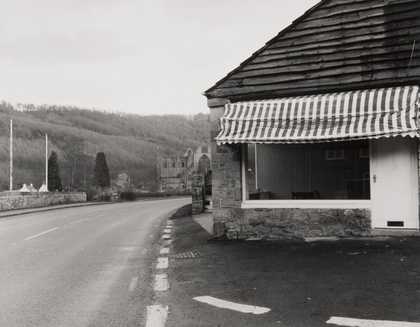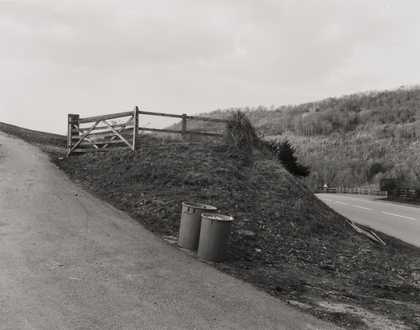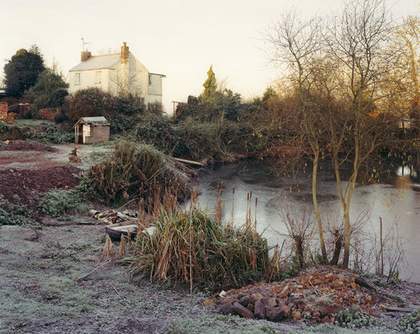
Keith Arnatt
A.O.N.B. (Area of Outstanding Natural Beauty) (1982–4)
Tate
The invention of photography very nearly coincided with the Romantic movement. Had Tom Wedgewood, friend and patron of Coleridge, and the chemist Humphry Davy been able to clinch their experiments with objects exposed to sunlight and paper coated with a solution of silver nitrate, would we now be able to speak of a Romantic photography? As it was, the last step eluded them, and they were unable to fix the images they had created. So photography found itself in the wake of Romanticism after all, extending rather than shaping its landscape project, or resisting it altogether.
The photographs at the end of the Romantics display at Tate Britain seem to question, perhaps even to satirise, Romantic responses to nature and the environment. So instead of atmosphere, spirit of place, heightened moments of awareness and reflections on antiquity and ruin, we get an emphasis on the mundane, the overlooked, the nondescript, an eye for dreck and failure. The theme of the room is British Landscape: Photography After the Picturesque, though, as it happens, the picturesque is very much played down.
Raymond Moore made some of his most characteristic work along a stretch of the Cumbrian coast in the far north-western corner of England, turning his back on the Lakeland mountains of poets and tourists to find strong sculptural subjects in places others might find bleak and unprepossessing. His image of a semi-detached house at Allonby is as rigorously pared-down as anything in Bill Brandt’s portfolio, but it is stripped, too, of any suggestion of neo-romantic melancholia. A crossing of paths in abraded grass by the sea at Maryport could at first sight be taken for a piece of land art. Moore’s reputation as a photographer’s photographer once seemed secure. It has slipped somewhat since his death in 1981: the continuing uncertainty over the future of his personal archive cannot have helped.

Keith Arnatt
A.O.N.B. (Area of Outstanding Natural Beauty) (1982–4)
Tate
If Moore made work close to an “area of outstanding natural beauty”, but chose to ignore it, Keith Arnatt was following a long-established scenic route, the Wye Valley, in his series A.O.N.B. of 1982–4. A light mockery is implicit in the title, with its suggestion that beauty is now something officially designated, framed by regulation and bureaucracy. Arnatt depicts a landscape that cannot fail but to live up to expectation, full of inappropriate intrusions and abject corners. In a picture of Tintern, the celebrated abbey itself is inconspicuous in the middle distance, while the foreground is dominated by a bald curve of tarmac and the façade of a café. This might appear to be a travesty of romantic landscape, but early tourists such as Gilpin were just as struck by pointed contrasts of grandeur and banality, and their excursions as much geared to pleasure and convenience.

Jem Southam
The Pond at Upton Pyne January 1997 (diptych) 1997
C-type print
Each 68 x 85 cm
Courtesy James Hyman Gallery © Jem Southam

Jem Southam
The Pond at Upton Pyne January 1997 (diptych) 1997
C-type print
Each 68 x 85 cm
Courtesy James Hyman Gallery © Jem Southam
Jem Southam’s diptych of an ice-bound pond at Upton Pyne, near Exeter, is part of a series documenting an attempt to improve a sorry piece of scenery. The pond is known locally as the Black Pit, an abandoned manganese mine that had become a rubbish dump and general eyesore. The owner of one of the adjacent properties embarked on a campaign to transform it into something that better corresponded to a picture, a natural-looking pond that would enhance rather than disgrace the village. But this benign intervention did not result in the desired idyll. The composition – house to the left, pond, encroaching trees – inevitably brings Constable’s The Hay Wain 1821 to mind, a well-managed counterpart to this scene of trial and error. At Upton Pyne, the attempt to realise the picturesque may have led only to disappointment, but the images recording it have a beauty all their own.
John Riddy’s large colour photographs of London are in obvious contrast to the emphasis on the rural and marginal elsewhere. Two of them have an oblique connection to the Romantics, though they also suggest how quickly traces are erased in the modern city. London (Wapping) 2008 shows some of the real estate on the thoroughly madeover waterfront. This is post-picturesque all right, and a far cry from the place to which Turner liked to retreat (he had property here, too, a pub called The Ship and Bladebone). London (Bank) 2008 is a flat blank wall with a statue of John Soane in a niche. Soane worked on his designs for the Bank of England for more than 40 years, and the result was his masterpiece; it proved an ephemeral monument, however, and hardly any of his fabric remains. Through his attentiveness to surfaces, Riddy reveals a city of many losses.
